This 11-day adventure China tour will start from the heart of China – Beijing. During this China adventure tour, you will not only touch the history of China, but you will also soak in the perfect East-meet-West culture in Hong Kong. You will get to see all the adventure highlights in China, including the Forbidden City, Great Wall, Terra Cotta Warriors, Li River Cruise, Victoria Peak, and more. Numerous aged historical sites, precious cultural relics, stunning natural landscapes and unique folk customs are all waiting for your exploration. We are also available to create your own tailor-made itinerary especially for you and your family. What are you waiting for? Come and join us on this best adventure tour in China.

Beijing is one of the "Four Great Ancient Capitals"(Xi’an, Luoyang, Nanjing and Beijing) of China. It is not only a modern, international city that combines Chinese politics, economy, culture and technology, but also exudes its unique old-world charm. There is the most luxurious residence in the world – Forbidden City, the most authentic Peking Roast Duck which has a history of more than 300 years, modern high-tech sports stadiums – Water Cube and Bird’s Nest which are the highlights during the 2008 Beijing Olympic Games, and the world’s wonder – Great Wall. Beijing is a magical city that you can’t forget once you know it.
Upon arrival, our guide and driver will meet & greet you at the airport. Then you will take a private vehicle to the hotel to rest. The rest day would be your free leisure time to discover the surroundings.
Today our Beijing adventure tour will start from the city heart of Beijing – Tian’anmen Square. With an area of 440,000 square meters, it can accommodate one million people for a grand gathering and is the largest city square in the world. Every morning, the national flag in the center of Tian’anmen Square has been raised no less than 20,000 times in the 65 years since the founding of New China. Every day, the red flag rises and falls together with the sun. That means, if you want to watch a flag ceremony during summer, you need to get up before 5 a.m. And if you want to stand in the front row, well, you need to get there at least before 4 a.m.
Walk through the Tian’anmen Square, we will reach the entrance of the Forbidden City (Closed each Monday). This is the place where you could have a deep view of the royal family lifestyle during the Ming and Qing Dynasties (1368-1912). When you enter the Forbidden City, you will see a lot of bronze lions which are full of imperial majesty. But the two bronze lions in front of the Gate of Heavenly Purity are drooping ears. Why? Because Gate of Heavenly Purity divides the Forbidden City into two parts, the inner and outer court. The outer court was where the emperor handled government affairs, while the inner court was where the harem lived. At that time, the Qing dynasty royal officials were forbidden to enter the inner court, and the harem was strictly forbidden to interfere with the imperial government affairs. And women were strictly forbidden to go to the outer court. The two drooping ears of the bronze lions are to warn the concubines not to listen or discuss any government affairs. The guide will take you to visit some residences of the concubines. After visiting the residence of the imperial family, we will have lunch at an authentic restaurant.
In the afternoon, we will drive to the Temple of Heaven which is located in the south of the Forbidden City. The Temple of Heaven was built in 1420 for the Ming and Qing emperors to worship God and pray for a bountiful harvest. Right now, it is a popular place for local people to do exercises. In ancient China, people believed that the sky was round and the earth was square. Therefore, the emperors of the Ming Dynasty (1368-1644) built most buildings inside the Temple of Heaven into a round shape. The most mysterious thing is the Hall of Prayer for Good Harvests. The whole building is round. And no matter which angle you look at it from, it looks exactly the same. The guide will tell you more interesting stories about the Temple of Heaven.
Our last stop today is Summer Palace. The Summer Palace is also one of the three major royal gardens of the Qing Dynasty (1636-1912). This is the place where the royal family spends their summer vacation. Because in ancient times, people did not have air conditioning. They also couldn't wear short sleeves and shorts. (During the Ming and Qing dynasties, no one was allowed to expose their arms and legs in public.) Summer was hard for them. So, every summer, the royal family moved to the cooler Summer Palace to spend the hot summer days. After visiting the Summer Palace, we will go back to the hotel overnight.
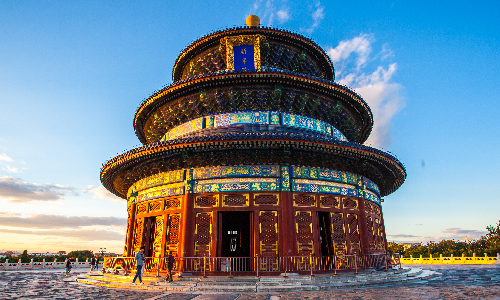
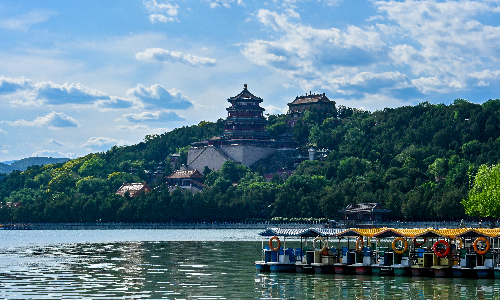
After breakfast, our adventure will start from the Ming Tombs which is located 44 kilometers north of the Forbidden City. We will drive for about 1 hour to reach the gate of the Ming Tombs. Ming Tombs is the general name for the royal tombs of the 13 emperors of the Ming Dynasty. In the 13 Ming Tombs, there is a “Guituo stele” (In Chinese, it means a stele carried on the back of the tortoise) in front of each tomb. This stele describes the achievements of the emperor when he was alive. According to the Chinese legends, the dragon had nine sons, each of whom had different preferences. One of the sons, who was good at carrying weight, was the tortoise. The emperor called himself the true dragon who was the son of God. And the tortoise is the son of the dragon, but also has the ability to carry things. So, it is quite logical to ask the tortoise to carry his father’s stele on his back.
Today we will visit the first tomb of all 13 Ming Tombs – Chang Tomb which is the tomb of the emperor Zhu Di. During the reign of Emperor Zhu Di, the country was rich and strong, so the tomb was also the largest. Lunch will be at a local restaurant on the way to the Great Wall.
Then we will get back on the bus and keep driving to the Juyongguan Great Wall which is located 20 kilometers northwest of the Ming Tombs. The Juyongguan Great Wall is the most dangerous and steepest pass of the Great Wall, and there are relatively fewer people. If you are in the good condition, we suggest you climb to the top. If not, you could climb to the No.9 Tower then return. After visiting, we will drive back to the hotel.
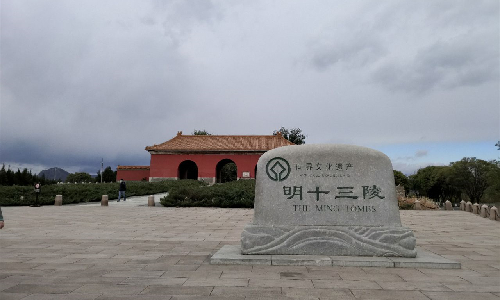
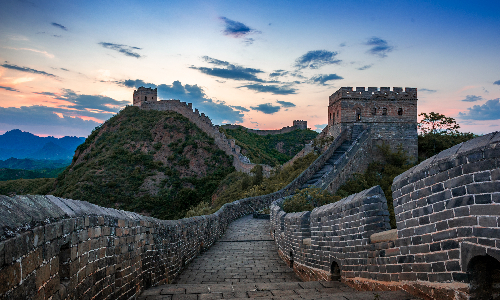
 Xi’an
Xi’an Today after checking out from the hotel, we will take you to the train station and take the estimated high-speed train G571 09:22/15:07 to Xi’an.
Xi'an is a very old city. It is one of the four most famous historical cities in the world, along with Athens in Greece, Rome in Italy and Cairo in Egypt. In Chinese history, Xi’an has been the capital for 13 dynasties for 1,140 years. Xi'an was called Chang'an in ancient times. In Chinese, “Chang” means a long time; “An” means secure. It was named Chang’an because the emperor of that time wanted the place to be long lasting and secure. Later, during the Ming Dynasty, Emperor Zhu Yuanzhang built the capital in Nanjing, and Xi’an was located to the west of Nanjing. So, he wanted this west city to be long lasting and peaceful, so he changed the name to Xi’an. In Chinese, Xi means west.
Our local guide at Xi’an will pick you up from the train station and drive to the Xi’an City Wall. The existing wall was built in the Ming Dynasty, with a total length of 13.7 kilometers and completed in 1378. The original Xi’an City Wall was made entirely of loess, lime and glutinous rice juice, making it exceptionally hard. Later, the entire inner and outer walls were covered with bricks. The top of the wall has a gutter made of bricks every 40-60 meters for drainage, which plays a very important role in the long-term protection of the ancient city wall of Xi'an. You will go to the top of the city wall and enjoy a full view of Xi’an city. After visiting, we will go to the hotel to rest.
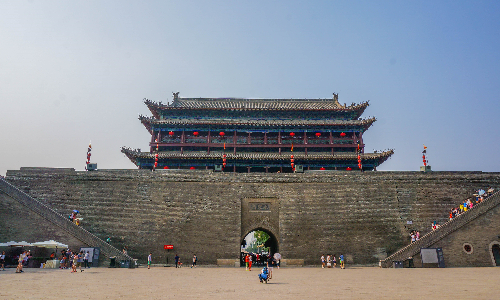
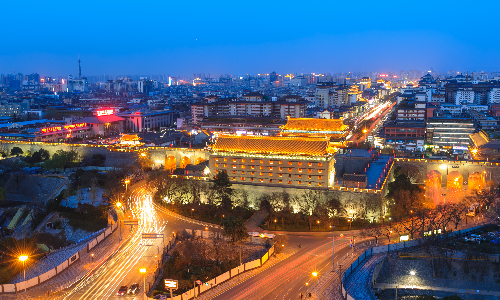
After breakfast, we will drive east for 1.5 hours (43 kilometers) to visit the Terra Cotta Warriors and Horses Museum which is a museum of ruins established on the original site of the Terracotta Warriors Pits, and the largest ancient military museum in China. There are three terracotta pits in the Terracotta Warriors Museum. What is most striking about the Terracotta Warriors is that, if you look closely, their faces and hairstyles, as well as their physiques and demeanor, are all different. It is also not difficult to imagine someone saying that the terracotta warriors are made of real people, just like mummies. The expressions of the Terra Cotta Warriors are also very individualized, not only to show character but even to locality. Many of the terracotta warriors' facial features are very similar to those of modern Shaanxi people. Identifying Chinese faces may be difficult for foreigners, but you can have a try. You could see if you can find some facial similarities between the Terra Cotta Warriors and local people. After admiring the Terra Cotta Warriors, we will have lunch at a local restaurant.
In the afternoon, we will drive about 1 hour to the downtown Xi’an and visit the Big Wild Goose Pagoda which is located 50 kilometers southwest of the Terra Cotta Warriors and Horses Museum. It was responsible for its construction by Master Xuan Zang. Those who are familiar with Buddhism must have heard this story. One day a pigeon ran up to the Buddha and asked him to shelter itself from being eaten by an eagle. After seeing the eagle chasing the pigeon, the Buddha began to persuade the eagle not to eat the pigeon. But the eagle did not listen and said to the Buddha, " You bless all the living beings in the world, am I not one of the living beings in the world? Today you won't let me eat this pigeon, what if I die of hunger?" When the Buddha heard this, he thought it was very reasonable. So, he cut off a piece of meat from his thigh and gave it to the eagle. Because of this reason, birds have always had a special place among the Buddhas. After the construction of the Big Wild Goose Pagoda was completed, Master Xuan Zang wanted to use the name of the bird to name the pagoda. In ancient China, the geese symbolized good luck and solidity. So, Master Xuan Zhang used Big Wild Goose Pagoda to name the pagoda. After the tour, we will go back to the hotel.
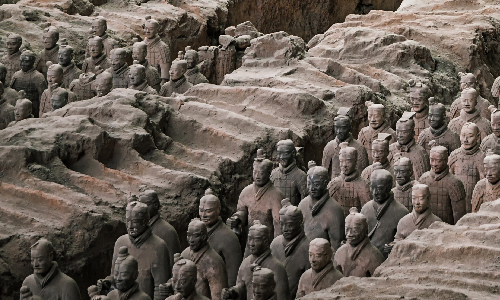
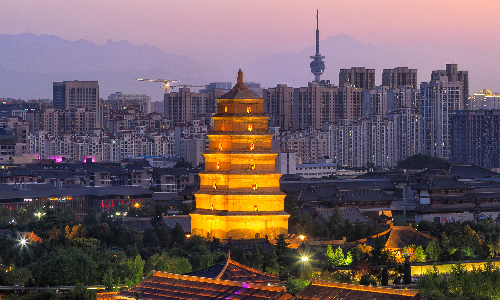
 Guilin
Guilin In the morning, the guide will take you to the airport. Today you will take the estimated flight JD5143 13:45/15:50 to Guilin. The climate is like spring in all seasons, with an average annual temperature of about 19°C(66.2°F). Even in winter, Guilin is full of fragrant Osmanthus flowers and rarely snows. In Guilin, the average temperature in winter is around 15℃(59°F), with the lowest being 8℃(46.4°F). Therefore, you can travel in this season by wearing spring and autumn clothes and bringing one or two pieces of winter clothes. Summer is the rainy season in Guilin, with most of the rain falling in May and June, making it the "Rainy Guilin". If you choose to travel at this time, do not forget to bring an umbrella in case you need it. There are many local specialties in Guilin especially the "Three Treasures”: three flowers wine, fermented bean curd and chili sauce. If you want to taste some local specialties, you could try Shatian grapefruit, Momordica Grosvenori (this is one of the fruit teas in China), Gingko, Water Chestnut, Bean Curd, Guilin Rice Noodles, Lotus Fish, etc. Our local guide in Guilin will meet and greet you at the airport and take you to the hotel to rest.
After breakfast, you will first experience the Li River Cruise. It is very pleasant to take a Li River cruise to visit the beautiful landscape of Guilin. The cruise departs from Guilin and arrives in Yangshuo, the whole journey takes about 4 hours. The lunch will be on the cruise. The landscape of the Li River is the essence of Guilin. On both sides of the Li River are mountains with different postures, among which the more representative ones are the Nine Horses Painting Mountain and the Yellow Cloth Reflection. U.S. President Bill Clinton also visited the Li River in Guilin during his 1998 visit to China. In the afternoon, the cruise docks at the pier in Yangshuo.
When we arrive, we will spend some leisure time on West Street at Yangshuo. West Street is the oldest street in Yangshuo County, with a history of more than 1,400 years. When Yangshuo County was established, the street is about 200 meters long and 5 meters wide. At that time, there were only a few stores dealing with daily necessities. And now the West Street is a collection of worlds for food, shopping and bar hopping. It has become a unique and beautiful scenery in Yangshuo. After spending some free time, we will drive back to Guilin.
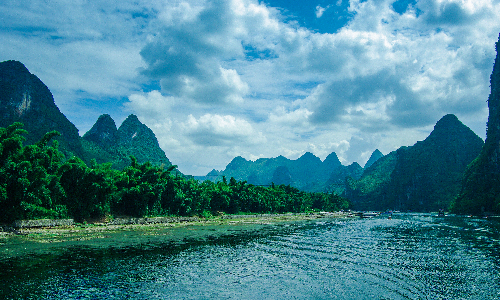
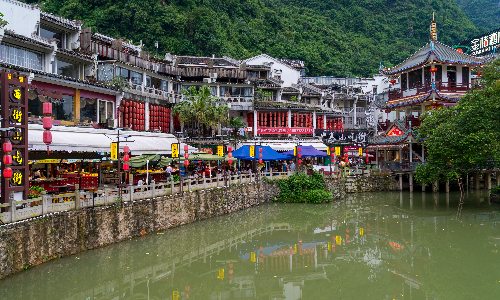
 Hong Kong
Hong Kong Today, our guide will take you to the train station. And you will take a high-speed train to Hong Kong to continue our trip.
October to May is the best time to visit Hong Kong. With an average temperature of 19°C(68°F), Hong Kong is warm and comfortable at this time, making it suitable for trips to Disney or outdoor activities such as hiking and climbing. Mandarin, Cantonese and English are all official languages of Hong Kong. Most of the store and restaurant waiters speak English, which is very convenient for English-speaking tourists. Upon arrival, the guide will wait for you at the train station and take you to the hotel. The rest day would be your free time to discover the surroundings.
This morning, our Hong Kong classic city tour will start from the Wong Tai Sin Temple. Speaking of the culture of Hong Kong people, it is impossible not to mention the belief in Wong Tai Sin. Wong Tai Sin Temple is the spiritual support of Hong Kong people. At the end of the lunar year and from the first to the fifteenth day of the first month, a large number of local people visit the Wong Tai Sin Temple to thank Wang Tai Sin for taking care of them in the past year and to seek Wang Tai Sin’s blessing for the new year.
The fortune sticks in Wong Tai Sin Temple are very famous for their accuracy. Visitors can find the fortune stick box next to the main hall. In total, there are 100 bamboo sticks in the box, respectively numbered 1-100. You could hold the box in front of the main hall and tell Wong Tai Sin your problem in your mind, shake the box until one of the bamboo sticks fall out. You need to remember the number on the fortune stick and go to the two-story building next to the main hall. That is the place for the interpretation of the fortune sticks, where there are many professional fortune-tellers. Each stick costs about HK$ 20 to HK$ 30. Wish you get the very best stick!
Then we will drive to the foot of Victoria Peak. Victoria Peak is one of Hong Kong's landmarks and the highest point in the city, where you can enjoy a stunning view of Hong Kong. You can take the antique Peak Tram to Victoria Peak, which is 1350 meters long with 5 stops, and is the first cable car system in Asia. Every visitor who comes to Hong Kong wants to get on peak tram, so every day, the queue for the peak tram is very long. The length of the queue can exceed tens of meters. If you go on the tour by yourself, you may need to wait in line for more than 2 hours. If you sign up for one of our tours, you can take the group pass. In 30 minutes at most, you can be on the peak tram to Victoria Peak. Also, the weather is quite important. If you encounter foggy weather, you can only see a blanket of white mist at the top of the mountain. It will affect the travel experience. If this happens, you can discuss with the tour guide whether to adjust the time to go to Victoria Peak.
When you reach the terminus of the Peak Tram, you will see the famous bowl-shaped building – the Peak Tower. It is a comprehensive tourist attraction with aerial views, shopping, dining and entertainment. There are 6 floors, 1-3 floors are mainly for food, with 4 different fashionable restaurants in Chinese, Western and Japanese, where you can dine while looking out over the scenery. You could ask the guide to give you some advice on the lunch restaurant suggestions. It also includes important attractions such as Madame Tussauds and the Peak Post Office, which are also must-see places for tourists visiting Hong Kong. The most famous attraction in this building is the Sky Terrace 428 which is the highest point in the Hong Kong city area. The view of Victoria Harbour from here is breathtaking, with the bustling Hong Kong at your feet. On the other side of the rooftop, you can see Lantau Island and the South China Sea from a distance. This is a popular place for visitors to take a photo with a splendid view of Victoria Harbour.
In the afternoon, we will drive to the south of Hong Kong Island to visit the Stanley Market. The Stanley Market is the liveliest place in Stanley, with a variety of small stores and stalls selling leather, silk, wool and cotton clothing, as well as Chinese handicrafts, watches and souvenirs, which tourists love to find here. After spending some free time at the Stanley Market, we will go back to the hotel to rest.
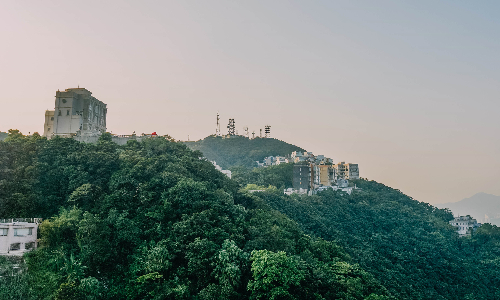

In the afternoon, we will visit the Tai O Fishing Village. Today, we will drive about 1 hour to visit Lantau Island which is located in the west of Hong Kong Island. We will get off the car and change the transportation when we arrive at the Ngong Ping 360 cable car station. It takes 20 minutes to reach Ngong Ping Village by cable car. If you are brave enough, you could choose the crystal cabin, with a transparent bottom on the cable car. When you arrive at the Ngong Ping Village, we will first visit the Po Lin Monastery.
Po Lin Monastery is home to the Tian Tan Buddha, which is also known as the Big Buddha, the symbol of Lantau Island. The 34-meter tall Tian Tan Buddha is the second-largest outdoor bronze seated Buddha statue in the world. The Buddha sits on a three-story high altar. To worship the Big Buddha, you need to climb 268 steps. After admiring the Big Buddha, you could enjoy a traditional vegetarian lunch in the temple. Or you could try the authentic desserts of Hong Kong – bean curd jelly at a dessert store on the Ngong Ping Village. You could ask the help from the guide for some lunch suggestions.
Tai O is the first fishing village developed on Lantau Island. The shanties built on the water are the characteristics of Tai O. The water shanties have a history of more than 200 years in Tai O. At that time, local fishermen used the fishing boat as their dwelling. When the fishermen’s children grew up and had their own children, it became very crowded for a large family to live on a fishing boat with everyone on board. So, they built water shanties by the shore. Each water shanty was supported by several wooden piles up 1-2 meters above the water and 2-3 meters deep below the water. The elderly and children lived in the water shanties while the fishing boat is parked on the water below the water shanties. This is something you can only see in the Tai O Fishing Village. You don’t want to miss that. There are also many famous local products at a really nice price in the Tai O Fishing Village. The most popular local products are salted fish, shrimp sauce, shrimp paste and fish maw, all of which are must-haves for tourists. You could buy some for your families and friends if they preferred seafood. After the tour, we will go back to the hotel overnight.
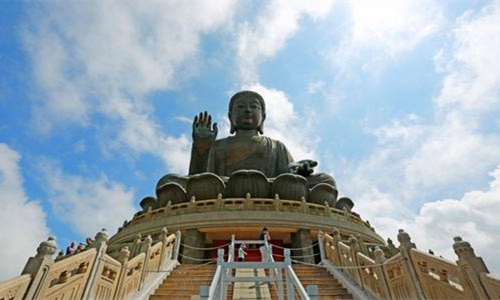
Today, the guide and driver will transfer you to the airport according to your flight. Your memorable China tour will end here. Our service also ends here.
Editor: Lexie Jia
Proofreader: Carrie Zhang
| City | Five Star hotel list | Four Star hotel list |
|---|---|---|
| Beijing | Sunworld Dynasty Hotel Beijing Wangfujing | Sunworld Hotel Wangfujing |
| Xi'an | Tianyu Gloria Grand Hotel Xi'an | Sunworld Dynasty Hotel |
| Guilin | Lijiang Waterfall Hotel | Guilin Bravo Hotel |
| Hong Kong | Harbour Grand Kowloon | Harbour Plaza North Point Hotel |
 |
![]() About your child or infant, please contact us for a discounted price.
About your child or infant, please contact us for a discounted price.



We started with a few days in Beijing & ended in Shanghai, from where we visited the Forbidden City and Great Wall. In between we visited Terra Cotta Warriors Museum, Panda Base, Shanghai Disneyland.

We had a wonderful holiday in China which will remain long in the memory. China is a breathtakingly beautiful country full of splendid temples and palaces, mountains and rivers, peaceful rural scenes and bustling shopping streets.
 QUICK ENQUIRY
QUICK ENQUIRY